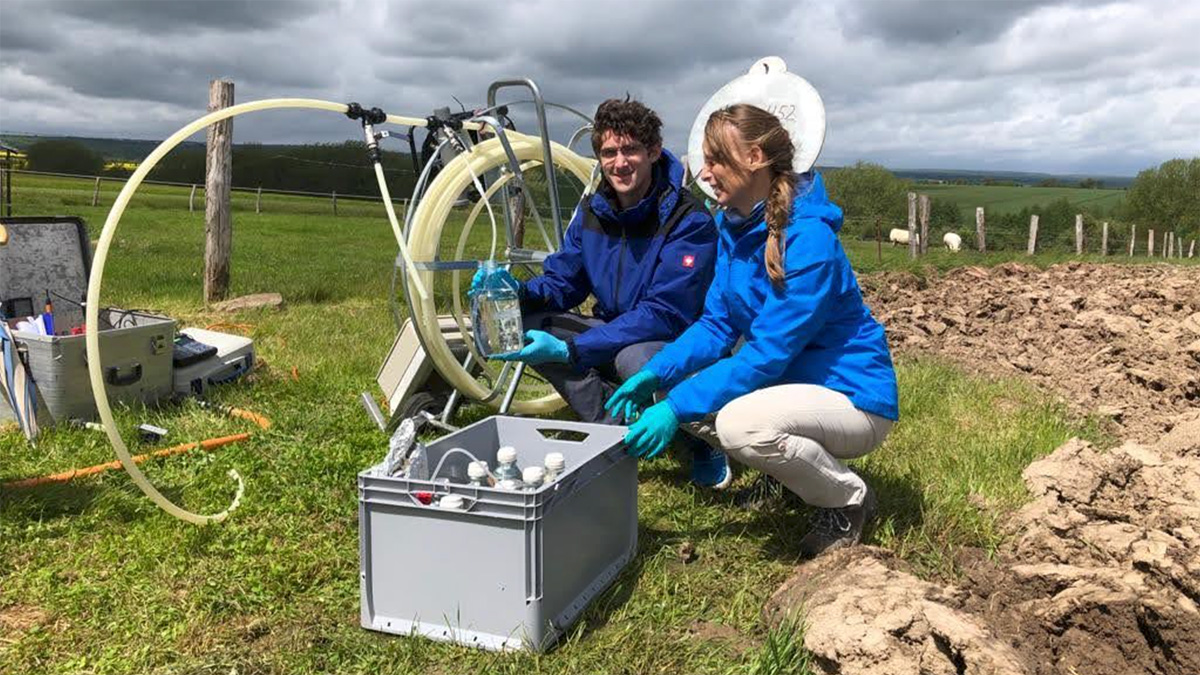Life in the deep was thought to mostly munch on carbon drifting in from above. But carbon fixation, which turns inorganic carbon into useful organic molecules, may be more widespread underground than realized. New research suggests that carbon fixation rates in some groundwaters are similar to those in some nutrient-poor surface waters.
“There’s a lot of fresh organic carbon being made in the subsurface where we’re not looking for it,” said Sunita Shah Walter, a biogeochemist at the University of Delaware who was not part of the new work. “It is happening, and it seems to be happening at pretty high rates.”
Microbial ecologist Will Overholt, geomicrobiologist Kirsten Küsel, and their colleagues collected groundwater from six wells between 5 and 90 meters belowground as part of the work at the Hainich Critical Zone Observatory in Germany. To those water samples, which harbored microbes from the deep, they added tiny amounts of radioactive carbon. Then, they used a sensitive technique called accelerator mass spectrometry to detect how much of that radioactive carbon microbes picked up.
“The fact that our rates were overlapping with the sunlit ocean waters was kind of mind blowing.”
“It was really hard to detect the new organic matter being produced by carbon fixation,” said Overholt, who works at Friedrich Schiller University Jena in Germany. “We think most microorganisms living there are under starvation conditions. There’s just not very many of them,” he said.
The carbon fixation rates measured for this karst limestone aquifer were around 10% of the median rate of global nutrient-poor (oligotrophic) surface waters, the researchers reported in Nature Geoscience. The carbon-fixing activity of these subsurface microbes even rivaled some measurements from microbes that live between 100 and 120 meters deep in the ocean. At those depths, most primary production occurs because of photosynthesis. “The fact that our rates were overlapping with the sunlit ocean waters was kind of mind-blowing,” Overholt said. Such areas, marine gyres in the middle of the ocean, are dominated by carbon-fixing cyanobacteria that photosynthesize. To look for what might be causing this carbon fixation, the researchers also took a census of microbes in their samples based on genetic material. They also wanted to understand where the microbes get the energy needed for this process. Similar to what they did in their experiments with carbon isotopes, the team spiked groundwater with isotope-labeled sources of nitrogen. The rates for a process that microbes use to gain energy from ammonium lined up closely with the carbon fixation rates. The team then looked to the organisms’ genes to infer how they fixed carbon.
These are potential rates, cautioned William Orsi, a geomicrobiologist at Ludwig-Maximilians-Universität München who was not part of the new work. What happens in a bottle at the surface is almost always faster than what’s happening in the actual environment because of differences in temperature, pH, or pressure or even the fact that it’s a closed system. “It doesn’t mean that’s the rate that’s actually happening down there,” he said. (Shah Walter noted that the researchers went to “great lengths” to minimize such bottle effects in this work.)
Underground Players in Carbon Cycle
Carbonate aquifers, like the one in this study, house some 2.26 million cubic kilometers of water. If the rate the team measured holds for other types of crystalline aquifers, which hold 12.66 cubic kilometers of water, microbes in these groundwater systems would account for 0.25% of the world’s total primary production, the team reported.
What the researchers observed at this site is important, said Magdalena Osburn, a geobiologist at Northwestern University who wasn’t involved with the study. But how quickly microbes fix carbon in an aquifer depends on factors including the water’s chemistry and how much easy-to-use carbon is already available.
With rates from a few other environments, researchers could start to get a handle on how much carbon is going into the subsurface, a carbon flux that is currently unaccounted for in climate models, Osburn said. If these subsurface environments are taking up carbon that’s filtering in through rainwater, that’s a contribution to the global carbon cycle that would be important to understand. “We don’t really know how much communication there is between the deep subsurface and the modern atmosphere.”
Carbon fixation in the subsurface may be more universal than realized.
Carbon fixation in the subsurface may be more universal than realized, said Shah Walter. She’s previously measured rates of carbon fixation in the crust under the ocean. And one of the new study’s coauthors found evidence for carbon fixation far deeper underground, below a geyser.
For a long time, researchers thought that subsurface ecosystems subsisted on old carbon from surface ecosystems that was difficult to break down. But this work and other studies suggest that there may be more fresh carbon that can sustain more complex ecosystems that turn over more quickly, Shah Walter said. “That’s the beginning of this whole chain of biological activity.” That seems to be the case with this karst system. Earlier work at the Hainich Critical Zone found that more complex food webs coincided with the abundance of genes for carbon fixation.
Redox energy, which comes from shuttling electrons between different chemicals, is what fuels most life on Earth, Shah Walter said. Exposure to sunlight is the source of most of that redox energy. It’s remarkable that this paper reported that such high carbon fixation rates are possible removed from that sunlight, she said. “If [microbes] find redox energy available to them anywhere, they’ll find a way to use it.”
“We have this increasing understanding that microbes are these chemical wizards,” Shah Walter said.
—Carolyn Wilke (@CarolynMWilke), Science Writer

